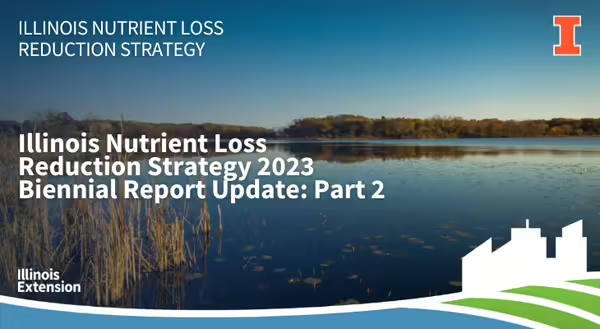
The loss of nutrients in Illinois lakes, streams, and rivers harms water quality locally and downstream, eventually leading to the Gulf of Mexico. The Illinois Nutrient Loss Reduction Strategy (NLRS) was established in 2015 and designed to reduce the nutrient loads in Illinois waterways and its negative impacts by exploring and recommending practical research based nutrient loss practices and collaborating with partners across the state. University of Illinois Extension’s outreach efforts for the NLRS includes the Nutrient Loss Reduction Podcast. In episode 58, we hear from the three different sectors outlined within the NLRS on how each sector is addressing nutrient loss along with some key points from 2021 and 2022 that are captured in the 2023 Biennial Report. In this blog post, we will cover the non-point source sector hearing from Brian Rennecker, Illinois Department of Agriculture (IDOA), and Jim Isermann, farmer and soil health specialist with the Illinois Sustainable Ag Partnership (ISAP).
IDOA Conservation initiatives and non-point source highlights
Brian Rennecker, third generation farmer and the Land and Water Resources Bureau Chief at IDOA discusses several conservation initiatives through the IDOA. Rennecker explains the significance of the Partners for Conservation Program (PFC) in addressing nutrient loss. This long-running initiative provides cost-share opportunities across all 97 Illinois Soil and Water Conservation Districts (SWCDs). The program helps farmers in implementing Farm Bill conservation projects that may not qualify for direct Farm Bill funds. For example, recently purchased land may not qualify for Farm Bill funds, but PFC can help offset the costs of crucial conservation practices like grassed waterways. Renneker also highlights another project by IDOA, Fall Covers for Spring Savings, now in its fifth year, supporting cover crops on an expanding scale – from 50,000 to 140,000 acres.
Rennecker emphasizes the commitment of Illinois, as evidenced by the 186 full-time members invested in government and non-government roles. In addition, he highlights that $51 million has been invested for education and outreach, showcasing the state's dedication to addressing nutrient loss. According to a 2022 NASS survey based on the 2021 growing season, Rennecker reveals that 76% of farmers used the Maximum Return to Nitrogen (MRTN) approach, while 85% utilized an N-inhibitor.
Farmer’s perspective
Jim Isermann, farmer from Streator, IL, and Soil Health Specialist with ISAP, brings a unique perspective to the conversation. As someone connected to the NLRS through multiple avenues including his corn/soy and cow/calf operation, he sees first-hand the importance of implementing conservation practices like strip-till, no-till and cover crops on his land. Isermann also reveals the role of ISAP in supporting NLRS goals through education and resources. ISAP provides education programs, presentations on soil health, cover crop management, and facilitating Advanced Soil Health Training (AHST) meetings for farmers and advisors across the state.
Why farmers should care about nutrient loss
Isermann discusses the benefits of conservation practices, including being good stewards of the land and the environment, and the economic value of in-field practices. Keeping nutrients, particularly nitrogen, in the field not only helps the environment but also contributes to cost savings for farmers. By keeping this valuable resource in the field, farmers are not only protecting their land but also avoiding losing their fertilizer as runoff into the environment.
Advice for farmers and landowners
Isermann outlines several avenues for farmers to achieve NLRS goals, including nitrogen management (utilizing tools like MRTN), in-field practices like cover crops and no-till, and edge-of-field practices such as wetlands and bioreactors. He stresses the importance of understanding the context of advice you are receiving and to adjust soil health principles and recommendations to each individual farming system.
To listen to the complete interviews with Brian and Jim as well as interviews with Trevor Sample, Illinois EPA, and Eliana Brown, University of Illinois Extension, check out Episode 58.
About the authors
Rachel Curry is an Agriculture and Agribusiness Educator focusing on agriculture and watershed education and is a part of the Illinois Extension's Nutrient Loss Reduction Strategy implementation team. Rachel earned a B.A. in Environmental Studies from Knox College and an M.S. in Environmental Science and Soil Science from Iowa State University with an emphasis on soil fertility. Her work focuses on education and outreach regarding the Illinois Nutrient Loss Reduction Strategy and agricultural conservation practices to reduce nutrient loss and improve water quality and soil health throughout Illinois
Nicole Haverback is a Watershed Outreach Associate and is a part of the Illinois Extension's Nutrient Loss Reduction Strategy implementation team. Nicole earned a BS in Agriculture and Rural Policy Studies from Iowa State University. She coordinates watershed and planning activities to reduce nutrient losses from priority watersheds, provides expertise on best management practices for nutrient loss, and conducts outreach on agricultural conservation practices outlined in the Illinois Nutrient Loss Reduction Strategy.
About the blog
At Illinois Extension, we’re working to improve water quality at home and downstream. Every month, our Watershed Outreach Associates will bring you stories highlighting agricultural conservation practices, current research projects and results, and from the field farmer interviews. The Nutrient Loss Reduction blog covers conservation practices recommended by the Illinois Nutrient Loss Reduction Strategy, timely updates, farm safety, and new decision tools to help farmers and producers reduce the nutrients leaving their field. Want to get notified when new blog posts are available? Subscribe at go.illinois.edu/SubscribeINLRS.